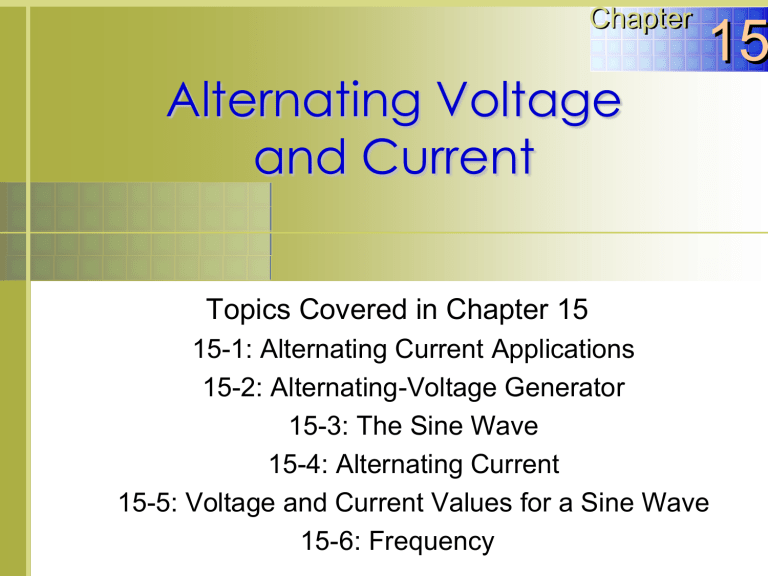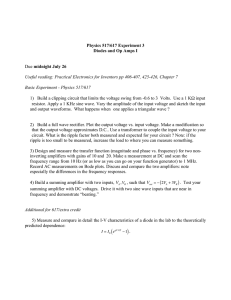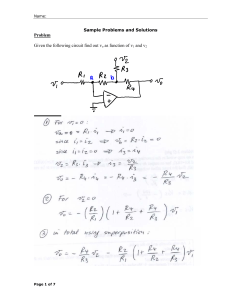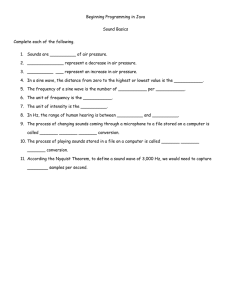
Chapter
Alternating Voltage
and Current
15
Topics Covered in Chapter 15
15-1: Alternating Current Applications
15-2: Alternating-Voltage Generator
15-3: The Sine Wave
15-4: Alternating Current
15-5: Voltage and Current Values for a Sine Wave
15-6: Frequency
Topics Covered in Chapter 15
15-7: Period
15-8: Wavelength
15-9: Phase Angle
15-10: The Time Factor in Frequency and Phase
15-11: Alternating Current Circuits with Resistance
15-12: Nonsinusoidal AC Waveforms
15-13: Harmonic Frequencies
15-14: The 60-Hz AC Power Line
15-16: Three-Phase AC Power
McGraw-Hill
© 2007 The McGraw-Hill Companies, Inc. All rights reserved.
15-1: Alternating Current
Applications
A transformer can only operate with alternating
current to step up or step down an ac voltage.
A transformer is an example of inductance in ac
circuits where the changing magnetic flux of a varying
current produces an induced voltage.
Capacitance is important with the changing electric
field of a varying voltage.
The effects of inductance and capacitance depend on
having an ac source.
An important application is a resonant circuit with L
and C that is tuned to a particular frequency.
15-2: Alternating-Voltage
Generator
Characteristics of Alternating Current
Alternating voltage and alternating current vary
continuously in magnitude and reverse in polarity.
One cycle includes the variations between two
successive points having the same value and varying in
the same direction.
Frequency is measured in hertz (Hz).
15-2: Alternating-Voltage
Generator
The Cycle
One complete revolution of the loop around the circle is
a cycle.
The half-cycle of revolution is called an alternation.
15-2: Alternating-Voltage
Generator
Angular Measure and Radian Measure
The cycle of voltage corresponds to
rotation of the loop around a circle,
so parts of the cycle are described in
angles.
The radian (rad) is an angle
equivalent to 57.3°.
A radian is the angular part of the
circle that includes an arc equal to
the radius r of the circle.
A circle’s circumference equals 2πr,
so one cycle equals 2π rad.
Copyright © The McGraw-Hill Companies, Inc. Permission required for reproduction or display.
Fig. 15-3(a).
15-2: Alternating-Voltage
Generator
Amplitude
Angular Measure and Radian Measure
0
0°
0 rad
90 °
/2 rad
180 °
rad
Copyright © The McGraw-Hill Companies, Inc. Permission required for reproduction or display.
270 °
360 °
3/2 rad
2 rad
15-3: The Sine Wave
The voltage waveform
pictured here is called a
sine wave, sinusoidal wave,
or sinusoid.
The induced voltage is
proportional to the sine of
the angle of rotation in the
circular motion producing
the voltage.
Fig. 15-1(a): Waveform of ac power-line voltage with frequency of 60 Hz. Two cycles are shown.
Oscilloscope readout.
Copyright © The McGraw-Hill Companies, Inc. Permission required for reproduction or display.
15-3: The Sine Wave
The instantaneous value of a sine-wave voltage for any
angle of rotation is expressed in the formula:
v = VM sin Θ
Θ (theta) is the angle
sin = the abbreviation for sine
VM = the maximum voltage value
v = the instantaneous value of voltage at angle Θ.
15-3: The Sine Wave
15-4: Alternating Current
Fig. 15-5: A sine wave of alternating voltage applied across R produces a sine wave of
alternating current in the circuit. (a) Waveform of applied voltage. (b) AC circuit. Note the symbol
for sine-wave generator V. (c) Waveform of current in the circuit.
Copyright © The McGraw-Hill Companies, Inc. Permission required for reproduction or display.
15-5: Voltage and Current Values
for a Sine Wave
The following specific magnitudes are used to compare
one wave to another:
Peak value: maximum value VM or IM. This applies to
the positive or negative peak.
Peak-to-peak: usually, but not always, double the peak value,
as it measures distance between two amplitudes.
Average value: Arithmetic average of all values in
one half-cycle (the full cycle average = 0).
Root-Mean-Square (RMS) or Effective Value:
Relates the amount of a sine wave of voltage or
current to the DC values that will produce the same
heating effect.
15-5: Voltage and Current Values
for a Sine Wave
The average value is 0.637 × peak value.
The rms value is 0.707 × peak value.
The peak value is 1.414 × rms value.
The peak-to-peak value is 2.828 × rms value.
15-5: Voltage and Current Values
for a Sine Wave
Fig. 15-6: Definitions of important amplitude values for a sine wave of voltage or current.
Copyright © The McGraw-Hill Companies, Inc. Permission required for reproduction or display.
15-5: Voltage and Current Values
for a Sine Wave
The default sine wave ac measurement is Vrms .
120 V
100 W
Vrms is the effective value.
The heating effect of these
two sources is identical.
+
120 V
100 W
Same power
dissipation
15-6: Frequency
Frequency ( f ) is the number of cycles per second.
Cycle is measured between two successive points
having the same value and direction.
One cycle per second is 1 Hz.
15-6: Frequency
Amplitude
Sine Wave Frequency
(two cycles shown)
0
Time
0.5 sec
f = 2 Hz
Copyright © The McGraw-Hill Companies, Inc. Permission required for reproduction or display.
1 sec
15-6: Frequency
Audio and Radio Frequencies
Audio range (frequencies of electrical variations heard
as sound waves by the human ear) is 16 to 16,000 Hz
Radio-frequency range is up to 300,000 MHz (300 GHz)
The higher the frequency, the higher the pitch of a
sound.
Amplitude has no relation to frequency. Amplitude
influences the loudness of a sound.
15-7: Period
Period (T) is the time per cycle.
T = 1/f
f = 1/T
The higher the frequency, the shorter the period.
15-7: Period
Period (T)
Amplitude
T
0
Time
0.0167 s
f = 1/T = 1/.0167 = 60 Hz
Copyright © The McGraw-Hill Companies, Inc. Permission required for reproduction or display.
15-8: Wavelength
Wavelength (λ) is the distance a wave travels in one
cycle.
λ = v/f, where:
λ = wavelength
λ=
1130 ft/s
f Hz
v = velocity of wave (such as sound or light)
in applications, velocity can be influenced by electromagnetic
fields, air pressure, etc.
f = frequency
15-8: Wavelength
The higher the frequency, the lower the wavelength.
The velocity of a radio wave is 3 × 1010 cms/s (3 × 108
meters/s).
15-8: Wavelength
Fig. 15-9: Wavelength λ is the distance traveled by the wave in one cycle.
Copyright © The McGraw-Hill Companies, Inc. Permission required for reproduction or display.
15-9: Phase Angle
Phase angle (Θ) is the angular difference between the
same points on two different waveforms of the same
frequency.
Two waveforms that have peaks and zeros at the
same time are in phase and have a phase angle of
0°.
When one sine wave is at its peak while another is at
zero, the two are 90° out of phase.
When one sine wave has just the opposite phase of
another, they are 180° out of phase.
15-9: Phase Angle
Fig. 15-10: Two sine-wave voltages 90° out of phase. (a) Wave B leads wave A by 90°. (b)
Corresponding phasors VB and VA for the two sine-wave voltages with phase angle Θ = 90°. The
right angle shows quadrature phase.
Copyright © The McGraw-Hill Companies, Inc. Permission required for reproduction or display.
15-9: Phase Angle
Phase-Angle Diagrams
The phasor corresponds
to the entire cycle of
voltage.
The phase angle of one
wave can be specified
only with respect to
another as a reference.
Usually the reference
phasor is horizontal.
Fig. 15-11: Leading and lagging phase angles for 90°. (a) When phasor VA is the horizontal
reference, phasor VB leads by 90°. (b) When phasor VB is the horizontal reference, phasor VA
lags by −90°.
Copyright © The McGraw-Hill Companies, Inc. Permission required for reproduction or display.
15-10: The Time Factor in
Frequency and Phase
The physical factors represented on waveforms are
variations in amplitude, usually on the vertical scale, with
respect to equal intervals on the horizontal scale, which can
represent either distance or time.
The angle of 360° represents the time for one cycle, or the
period T.
The phase angle between two waves of the same frequency
indicates a specific difference in time.
The time for a phase angle can be calculated as
t=
Θ
1
×
f
360
15-10: The Time Factor in
Frequency and Phase
15-11: Alternating Current Circuits
with Resistance
Series AC Circuit with R.
The 4-A current is the
same in all parts of the
series circuit. (Note: This
principle applies for either
an ac or dc source.)
The series voltage drops
are equal to V = I x R
The sum of the individual
IR drops equals the
applied voltage (120V).
Fig. 15-16: Series ac circuit with resistance only.
Copyright © The McGraw-Hill Companies, Inc. Permission required for reproduction or display.
15-12: Nonsinusoidal AC
Waveforms
In many electronic applications, other waveforms
besides sine and cosine are important. Some of those
forms are shown below.
Square wave
Sawtooth wave
Pulse wave
Copyright © The McGraw-Hill Companies, Inc. Permission required for reproduction or display.
Common in digital
electronic circuitry
Used in timing
and control
circuitry
Used in digital
and control
circuitry
15-12: Nonsinusoidal AC
Waveforms
Key Similarities and Differences between Sinusoidal
and Nonsinusoidal Waveforms
For all waveforms, the cycle is measured between two
points having the same amplitude and varying in the
same direction.
Peak amplitude is measured from the zero axis to the
maximum positive or negative value.
Peak-to-peak amplitude is better for measuring
nonsinusoidal waveshapes because they can have
unsymmetrical peaks.
15-12: Nonsinusoidal AC
Waveforms
Key Similarities and Differences between Sinusoidal
and Nonsinusoidal Waveforms
The rms value 0.707 applies only to sine waves.
Phase angles apply only to sine waves.
All the waveforms represent ac voltages. Positive
values are shown above the zero axis, and negative
values are shown below the axis.
15-13: Harmonic Frequencies
Harmonic frequencies are exact multiples of the
fundamental frequency.
Harmonics are useful in analyzing distorted sine waves
or nonsinusoidal waveforms.
15-13: Harmonic Frequencies
Fig. 15-20: Fundamental and harmonic frequencies for an example of a 100-Hz square wave.
Copyright © The McGraw-Hill Companies, Inc. Permission required for reproduction or display.
15-14: The 60-Hz AC Power Line
Almost all homes in the US are supplied alternating
voltage between 115 and 125 V rms, at a frequency of
60 Hz.
The incoming voltage is wired to all the wall outlets and
electrical equipment in parallel.
The 120-V source of commercial electricity is the 60-Hz
power line or the mains, indicating that it is the main
line for all the parallel branches.
15-14: The 60-Hz AC Power Line
Grounding
Grounding is the practice of connecting one side of the
power line to earth or ground.
The purpose is safety:
Grounding provides protection against dangerous
electric shock.
The power distribution lines are protected against
excessively high voltage, particularly from lightning.
15-14: The 60-Hz AC Power Line
Grounding
Plug connectors for the ac power line are configured to
provide protection because they are polarized with
respect to the ground connections.
Fig. 15-22: Plug connectors polarized for ground connection to an ac power line. (a) Wider blade
connects to neutral. (b) Rounded pin connects to ground.
Copyright © The McGraw-Hill Companies, Inc. Permission required for reproduction or display.
15-14: The 60-Hz AC Power Line
Grounding
The ground-fault circuit
interrupter (GFCI) is a
device that can sense
excessive leakage current
and open the circuit as a
protection against shock.
Fig. 15-23: Ground-fault circuit interrupter (GFCI).
Copyright © The McGraw-Hill Companies, Inc. Permission required for reproduction or display.
15-16: Three-Phase AC Power
Three-phase ac power has three legs that are 120° out
of phase.
The advantage of three-phase ac voltage is more
efficient distribution of power.
Fig. 15-25: Three-phase alternating voltage or current with 120° between each phase. (a) Sine
waves. (b) Phasor diagram.
Copyright © The McGraw-Hill Companies, Inc. Permission required for reproduction or display.





